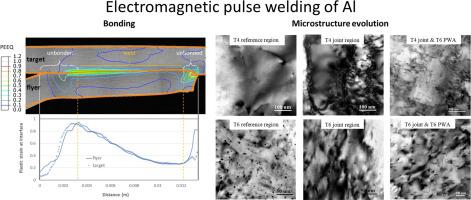当前位置:
X-MOL 学术
›
J. Mater. Process. Tech.
›
论文详情
Our official English website, www.x-mol.net, welcomes your
feedback! (Note: you will need to create a separate account there.)
Bonding and microstructure evolution in electromagnetic pulse welding of hardenable Al alloys
Journal of Materials Processing Technology ( IF 6.7 ) Pub Date : 2021-04-01 , DOI: 10.1016/j.jmatprotec.2020.116965 Z. Li , E. Beslin , A.J. den Bakker , G. Scamans , M. Danaie , C.A. Williams , H. Assadi
Journal of Materials Processing Technology ( IF 6.7 ) Pub Date : 2021-04-01 , DOI: 10.1016/j.jmatprotec.2020.116965 Z. Li , E. Beslin , A.J. den Bakker , G. Scamans , M. Danaie , C.A. Williams , H. Assadi

|
Abstract Electromagnetic pulse welding (EMPW) is a promising solid-state joining process, offering fast and strong bonding with no heat affected zone. Despite the growing interest in this process, there is little understanding of the dynamic phenomena that lead to bonding and microstructural changes during EMPW of key engineering materials such as age-hardenable aluminium alloys. This study combines experiments with numerical modelling of plastic deformation to provide an insight to these phenomena in joining of a high-strength aluminium alloy in the T4 and T6 temper conditions. Initially, bonding criteria are postulated in view of the calculated plastic strain at the interface of the T4 sample. These criteria are then used for the prediction of the extent of bonded interfaces for different sets of materials and process parameters. The predictions are shown to be in quantitative agreement with the experimental results for the T6 sample. The corresponding microstructural studies show that bonding is associated with remarkable microstructural changes in the samples, including dissolution of precipitates, formation of high-angle boundaries, and recrystallisation, especially near the bonded interfaces. Moreover, the results of post-weld heat treatments and mechanical testing demonstrate that the impact-induced deformation in EMPW can also influence subsequent precipitations, hence result in improved properties of the entire sample, in a way not achievable by conventional age hardening treatments.
中文翻译:

可淬硬铝合金电磁脉冲焊接中的结合和微观结构演变
摘要 电磁脉冲焊接 (EMPW) 是一种很有前途的固态连接工艺,可提供快速而牢固的接合,且没有热影响区。尽管人们对这一过程越来越感兴趣,但对关键工程材料(如时效硬化铝合金)在 EMPW 过程中导致键合和微观结构变化的动态现象知之甚少。本研究将实验与塑性变形的数值模拟相结合,以深入了解在 T4 和 T6 回火条件下连接高强度铝合金时的这些现象。最初,结合标准是根据 T4 样品界面处计算出的塑性应变来假设的。然后将这些标准用于预测不同组材料和工艺参数的粘合界面范围。预测结果与 T6 样品的实验结果在定量上一致。相应的微观结构研究表明,结合与样品中显着的微观结构变化有关,包括沉淀物的溶解、高角度边界的形成和再结晶,尤其是在结合界面附近。此外,焊后热处理和机械测试的结果表明,EMPW 中的冲击引起的变形也会影响随后的沉淀,从而导致整个样品的性能得到改善,这是传统时效硬化处理无法实现的。相应的微观结构研究表明,结合与样品中显着的微观结构变化有关,包括沉淀物的溶解、高角度边界的形成和再结晶,尤其是在结合界面附近。此外,焊后热处理和机械测试的结果表明,EMPW 中的冲击引起的变形也会影响随后的沉淀,从而导致整个样品的性能得到改善,这是传统时效硬化处理无法实现的。相应的微观结构研究表明,结合与样品中显着的微观结构变化有关,包括沉淀物的溶解、高角度边界的形成和再结晶,尤其是在结合界面附近。此外,焊后热处理和机械测试的结果表明,EMPW 中的冲击引起的变形也会影响随后的沉淀,从而导致整个样品的性能得到改善,这是传统时效硬化处理无法实现的。
更新日期:2021-04-01
中文翻译:

可淬硬铝合金电磁脉冲焊接中的结合和微观结构演变
摘要 电磁脉冲焊接 (EMPW) 是一种很有前途的固态连接工艺,可提供快速而牢固的接合,且没有热影响区。尽管人们对这一过程越来越感兴趣,但对关键工程材料(如时效硬化铝合金)在 EMPW 过程中导致键合和微观结构变化的动态现象知之甚少。本研究将实验与塑性变形的数值模拟相结合,以深入了解在 T4 和 T6 回火条件下连接高强度铝合金时的这些现象。最初,结合标准是根据 T4 样品界面处计算出的塑性应变来假设的。然后将这些标准用于预测不同组材料和工艺参数的粘合界面范围。预测结果与 T6 样品的实验结果在定量上一致。相应的微观结构研究表明,结合与样品中显着的微观结构变化有关,包括沉淀物的溶解、高角度边界的形成和再结晶,尤其是在结合界面附近。此外,焊后热处理和机械测试的结果表明,EMPW 中的冲击引起的变形也会影响随后的沉淀,从而导致整个样品的性能得到改善,这是传统时效硬化处理无法实现的。相应的微观结构研究表明,结合与样品中显着的微观结构变化有关,包括沉淀物的溶解、高角度边界的形成和再结晶,尤其是在结合界面附近。此外,焊后热处理和机械测试的结果表明,EMPW 中的冲击引起的变形也会影响随后的沉淀,从而导致整个样品的性能得到改善,这是传统时效硬化处理无法实现的。相应的微观结构研究表明,结合与样品中显着的微观结构变化有关,包括沉淀物的溶解、高角度边界的形成和再结晶,尤其是在结合界面附近。此外,焊后热处理和机械测试的结果表明,EMPW 中的冲击引起的变形也会影响随后的沉淀,从而导致整个样品的性能得到改善,这是传统时效硬化处理无法实现的。











































 京公网安备 11010802027423号
京公网安备 11010802027423号